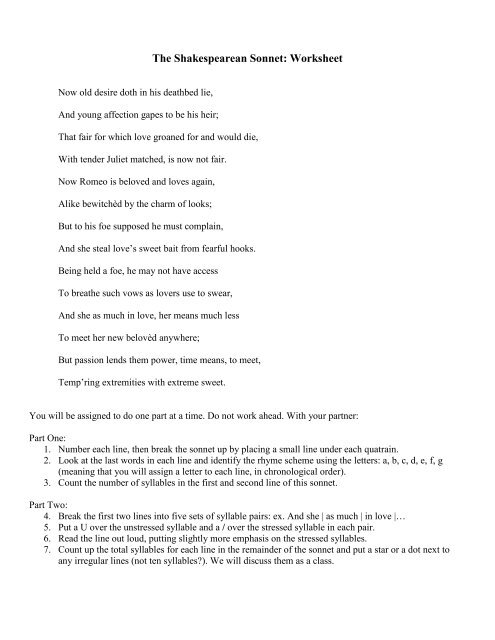The Shakespearean Sonnet: Worksheet
The Shakespearean Sonnet: Worksheet
The Shakespearean Sonnet: Worksheet
Create successful ePaper yourself
Turn your PDF publications into a flip-book with our unique Google optimized e-Paper software.
Now old desire doth in his deathbed lie,<br />
And young affection gapes to be his heir;<br />
<strong>The</strong> <strong>Shakespearean</strong> <strong>Sonnet</strong>: <strong>Worksheet</strong><br />
That fair for which love groaned for and would die,<br />
With tender Juliet matched, is now not fair.<br />
Now Romeo is beloved and loves again,<br />
Alike bewitchèd by the charm of looks;<br />
But to his foe supposed he must complain,<br />
And she steal love’s sweet bait from fearful hooks.<br />
Being held a foe, he may not have access<br />
To breathe such vows as lovers use to swear,<br />
And she as much in love, her means much less<br />
To meet her new belovèd anywhere;<br />
But passion lends them power, time means, to meet,<br />
Temp’ring extremities with extreme sweet.<br />
You will be assigned to do one part at a time. Do not work ahead. With your partner:<br />
Part One:<br />
1. Number each line, then break the sonnet up by placing a small line under each quatrain.<br />
2. Look at the last words in each line and identify the rhyme scheme using the letters: a, b, c, d, e, f, g<br />
(meaning that you will assign a letter to each line, in chronological order).<br />
3. Count the number of syllables in the first and second line of this sonnet.<br />
Part Two:<br />
4. Break the first two lines into five sets of syllable pairs: ex. And she | as much | in love |…<br />
5. Put a U over the unstressed syllable and a / over the stressed syllable in each pair.<br />
6. Read the line out loud, putting slightly more emphasis on the stressed syllables.<br />
7. Count up the total syllables for each line in the remainder of the sonnet and put a star or a dot next to<br />
any irregular lines (not ten syllables?). We will discuss them as a class.
<strong>Shakespearean</strong> <strong>Sonnet</strong> notes:<br />
Part One:<br />
A sonnet is:<br />
A <strong>Shakespearean</strong> or Elizabethan sonnet contains:<br />
A quatrain is:<br />
A couplet is:<br />
<strong>The</strong> <strong>Shakespearean</strong> sonnet rhyme scheme is:<br />
Question:<br />
What are the sonnets we have encountered so far in R&J?<br />
Part Two:<br />
<strong>The</strong> type of meter used in <strong>Shakespearean</strong> sonnets is:<br />
<strong>The</strong> meter of a poem is:<br />
An iamb is:<br />
An unaccented syllable is identified with a:<br />
An accented syllable is identified with a:<br />
Pentameter means:<br />
<strong>The</strong>refore, if an iamb contains two syllables, and there are five total iambs in each line, the total number of<br />
syllables per line in a <strong>Shakespearean</strong> sonnet is:<br />
*Why iambic pentameter?<br />
(NOTES KEY BELOW)
<strong>Shakespearean</strong> <strong>Sonnet</strong> OTES:<br />
Part One:<br />
A sonnet is:<br />
a lyric poem consisting of fourteen lines.<br />
A <strong>Shakespearean</strong> or Elizabethan sonnet contains:<br />
three quatrains (four lines each) and a final rhyming couplet (two lines)<br />
A quatrain is: One of three four-line stanzas in a <strong>Shakespearean</strong> sonnet.<br />
A couplet is: <strong>The</strong> final two rhyming lines in a <strong>Shakespearean</strong> sonnet.<br />
<strong>The</strong> <strong>Shakespearean</strong> sonnet rhyme scheme is: abab, cdcd, efef, gg<br />
Question:<br />
What are the three sonnets we have encountered so far in R&J?<br />
2 prologues – beginning and end of Act I<br />
I, v, 102-116) – when Romeo and Juliet first meet at the ball<br />
Part Two:<br />
<strong>The</strong> type of meter used in <strong>Shakespearean</strong> sonnets is:<br />
iambic pentameter.<br />
<strong>The</strong> meter of a poem is:<br />
its rhythm of accented or unaccented syllables organized into patterns called feet.<br />
An iamb is:<br />
a foot consisting of two syllables, one unaccented (unstressed) and one accented (stressed).<br />
An unaccented syllable is identified with a: U<br />
An accented syllable is identified with a: /<br />
Pentameter means:<br />
five feet (pent is Greek root for five). So, each line in a sonnet contains five iambs.<br />
<strong>The</strong>refore, if an iamb contains two syllables, and there are five total iambs in each line, the total number of<br />
syllables per line in a <strong>Shakespearean</strong> sonnet is: 10<br />
*Why iambic pentameter:<br />
- Because it reflects the natural rhythm of the human heartbeat<br />
- Because it is the rhythm most common to our natural way of speaking.




